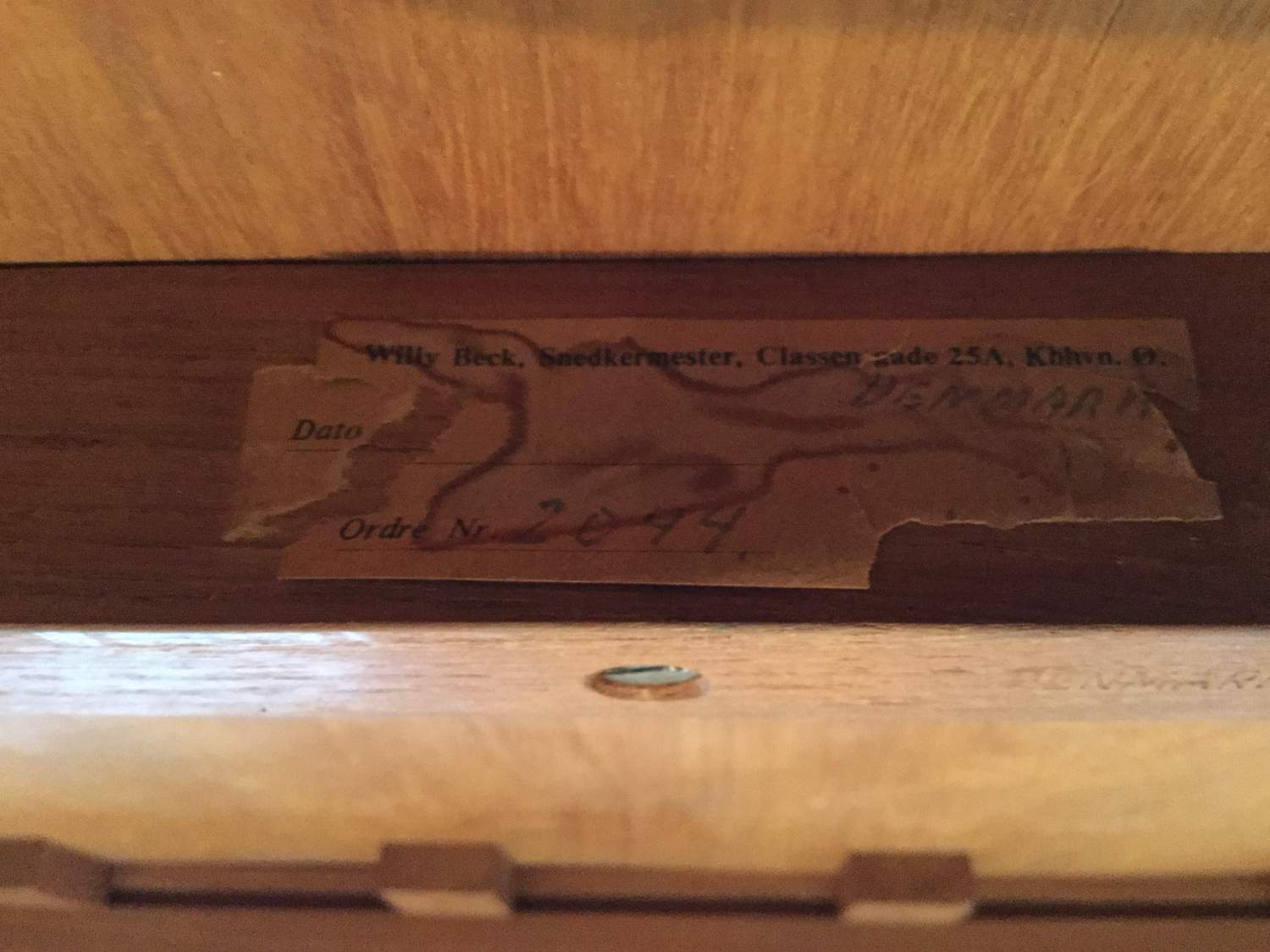Based on a recent acquisition, I decided to start a dedicated thread on the Danish cabinetmaker, Willy Beck. Based in Copenhagen, Willy Beck participated in the Cabinetmakers Guild Exhibitions from 1942-1966. Like many of the cabinetmakers of that time, Willy Beck teamed with a primary architect(s) to produce designs for these exhibitions (e.g. Johannes Hansen / Hans Wegner, and Niels Vodder / Finn Juhl), which were used to attract attention and furniture orders for the following year. Ejner Larsen and Aksel Bender Madsen was the main architect team for Willy Beck during the 40's and 50's, with collaboration expanding to other designers during the 60's.
A couple of weeks ago, a round teak dining table popped up on craigslist that had a Willy Beck label on it. As Willy Beck is not nearly as well known as other cabinetmakers, like those noted above, the listing lasted a few days and was priced very reasonably. Thus I was able to acquire it when the weekend rolled around.
While the table is not specifically included in the Grete Jalk guild exhibition volumes, I believe that it was part of the 1949 collection, designed by Larsen and Bender Madsen, based on similarities to a desk from that year, including:
1) solid teak construction, not just for the table top, but rails and legs as well.
2) brass sabots (feet); the sabot length is longer on the desk than my table
3) stepped and chamfered profiles for the underside of the rails.
4) one of the reviews for the '49 exhibition noted that Larsen and Bender Madsen had "designed a whole range of beautiful furniture for Willy Beck" that year.
One of the interesting details of the table can be seen on the underside. As leif has noted numerous times on this site, solid teak table tops require an understanding of the wood expansion properties in order to properly design a table that will not tear itself apart. The strategy for this table top connection is very straightforward and easy to understand at first sight. The table top is not glued/screwed/boltedto the rails/legs. Rather, multiple small teak brackets are spaced around the perimeter and screwed to the table top. The flanges of these brackets precisely fit into a continuous groove routed into the inside of the rails. These connections are tight enough to create a sturdy table construction, but also allow for the table top to expand and contract, as the flanges slide inside the grooves. A central tapered teak bar is also screwed to the table top, but passes through the rails. This locks the top into a symmetrical relationship with the base, allowing the expansion to move outwards in both directions.
Another characteristic of this cabinetmaker piece is that the legs are not removable like most dining tables. It is possible to separate the table top from the base by unscrewing each of the teak brackets, as well as the central bar. Even in that scenario, the rails and legs are still jointed and glued together as a single piece. This makes transportation not as convenient as the typical table with bolted legs. <img class="wpforo-default-imag
<img class="wpforo-default-imag
Research
In all the searching I've done so far over the last three weeks, there was only one other example I could find online. It was initially odd that the other example was a sold listing here in Chicago. However, once I got my hands on the table, I was able to examine the wood grain with detailed photos of the sold listing, and realized that they are the same table.
I did come across a Willy Beck catalog from a Lauritz listing a couple of years ago. But unfortunately for me, Lauritz did not scan the catalog for their own reference before the auction.
There is also a Willy Beck Snedkermester book in three libraries in Europe. I contacted them, but unfortunately once again, the book was not a catalog and did not have my table within.


Cleaning
The table was in very good condition when bought, with no wood damage or repairs (there are the usual vintage wear marks and scratches). The finish of the table top did have some issues, with some splotchy worn areas showing lighter teak below. The overall finish was darker, but more grime than patina.
Therefore, I chose to go with Murphy's Oil Soap for the first step (for table top only; the rails and legs had a nice "clean patina" to them, if that makes any sense). I used heated Murphy's without dilution, with a 3M green scrubbing pad rinsed frequently with hot water. A moist hot towel then wiped up the dirt slurry after scrubbing. Although I had used Murphy's a few times previously, I was surprised by how much the finish cleared up. The top was momentarily dry before an oiling/waxing brought back a nice satin sheen. The closeup photo was taken right after the oiling and is not as shiny any more.
This Willy Beck has been rotated into the collection as the new kitchen table, replacing a highly-figured Hundevad rosewood game table that I thought would remain there for a long time. The curved backs of my Erik Christensen Slagelse boomerang chairs match the round table nicely. The kitchen layout is currently a bit tight, and I eventually need to do some rearranging.
Thanks to leif and jesgord for research help along the way.
It would be good for others to post their Willy Beck pieces here as well, so this can become a good comprehensive thread,


If you need any help, please contact us at – info@designaddict.com









